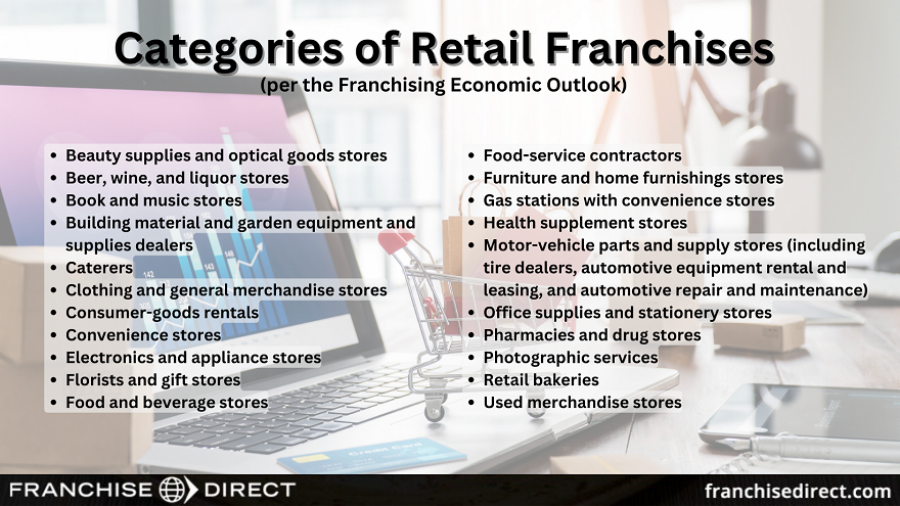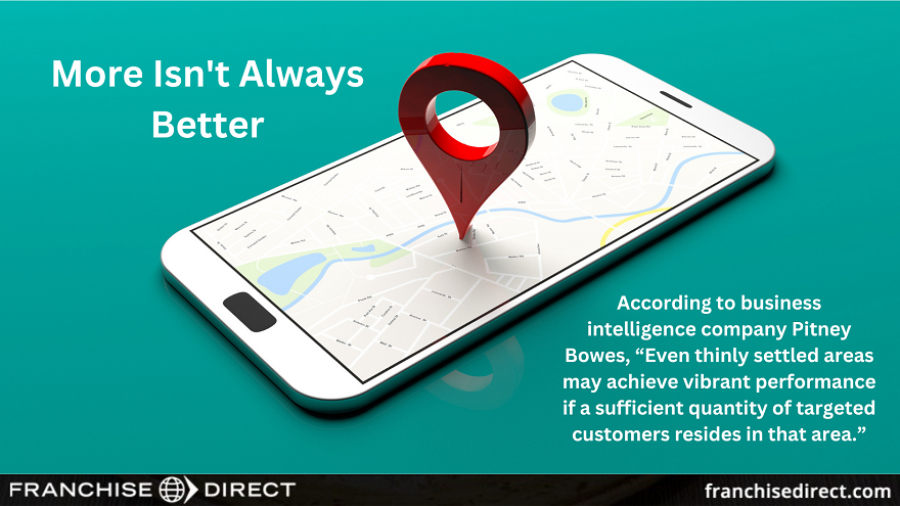🕒Estimated Reading Time: ~9 minutes

Many potential business owners are finding franchising a more attractive path in starting a retail business than going at it independently. With the franchisor supplying an established brand, marketing help, ongoing support and advice, as well as better economies of scale commonly, a franchisee has an increased chance of success – so long as the franchise system is followed.
This report gives background on the retail franchise industry as well as a few of the main trends affecting it.
Defining Retail
Although clothing comes to mind quickly when people think of retail, retail exists in virtually every industry. The unifying aspect of retail businesses is that they all involve the sale of a product. Though, some also provide services, such as repair and installation, that correspond with and/or complement the product(s) sold. In fact, the North American Industry Classification System (NAICS) specifies 75 retail store types.
The United States Bureau of Labor Statistics (BLS) classifies retail as a category within the broader trade, transportation, and utilities super sector. According to the BLS, retailing is the last step in the distribution of merchandise. Retailers sell their wares in small quantities to the public. There are two main types of retailers: store and non-store.
The first type, store retailers, operate from fixed point-of-sale locations or some kind of physical premises. Typically, these retailers sell merchandise to the public for personal or household consumption, but some also sell to business and institutional clients.
The second type, non-store retailers, sell products to customers and market merchandise with more “non-traditional methods.” The BLS categorizes non-store retailers as ones that reach their customers via the broadcasting of infomercials, the broadcasting and publishing of direct-response advertising, the publishing of paper and electronic catalogs, door-to-door solicitation, in-home demonstration, selling from portable stalls (all street vendors except for food ones), as well as distribution through vending machines.
You can find franchises that utilize either type of retailing, sometimes both.
The Retail Franchise Industry
As per the Franchising Economic Outlook, the following areas make up the retail food, products, and services franchise category:

All franchises combined in this area directly brought in an estimated $130 billion dollars in 2022. According to the 2023 Franchising Economic Outlook, “Pent-up consumer demand generated strong growth in 2021 and helped sustain impressive momentum throughout 2022.”
Retail Franchise Future Outlook
The outlook for the retail franchise industry tends to coincide with the overall economy. The more disposable income consumers have the better. The 2023 Franchising Economic Outlook forecasts a 3.2% increase, or $4 billion rise, in franchise retail output over the 2022 total for 2023.
The pandemic quickened the evolution of the retail franchise industry as it pertains to the merging of in-store and out-of-store experiences for customers.
As FRANdata anticipates, “the industry will now focus on increasing customer touchpoints by providing holistic solutions to their customers. For example, retailers have long offered services such as curbside pickup, same-day delivery, and ‘buy now, pay later’ payment options to improve the consumer experience.” But now, they are integral to success. Like other industries, franchise brands will be increasing their use of customer data and technology to increase revenue.
Furthermore, FRANdata also notes that retail franchisors are also increasingly leaning on loyalty programs. For example, per the company, “retailers are combining buy online, pick up in store (BOPIS) with in-app loyalty programs that allow for discounts or inclusive product access to keep customers coming back.”
Big Trend: The Retailing of Healthcare
Think about a strip mall near where you live. There probably have always been health-related franchises such as Pearle Vision, Miracle-Ear, or LensCrafters. However, over the years you’ve likely seen an increase in other healthcare-based retail franchises too.
Why? According to McKinsey, a worldwide management consulting firm, healthcare providers have begun to adopt goals that mirror the objectives traditional retailers have followed over the years. These aims include:
- Distributed settings of care
- Locations that answer consumers’ growing demand for convenience
- Lower cost, less capital-intensive care delivery systems
- Solutions that optimize scale within local markets
The phenomenon is like the consumer shift away from centralized shopping, aka malls, within the last decade.
In and around the 1980s, shopping consolidated into malls that drew their customers from a decent-sized market area. In recent years, however, consumers have shifted their shopping patterns back towards specialized stores located in strip malls. In many cases, these strip malls are closer to them than the nearest mall. The retail industry reacted by creating smaller, more accessible store types. In a similar way, healthcare providers are shifting towards these more customer-convenient setups.
Consider this: A 2018 study titled “The State of Consumer Healthcare” revealed that 81% of people are dissatisfied with their traditional healthcare experiences. In response, some healthcare businesses have embraced retail concepts, making their locations just like stores or spas—and it’s working.
“Most outpatient care is ripe for an experience makeover, including: urgent care, dental, physical therapy, sports medicine, allergy, and primary care,” says Dan Stanek, EVP of WD Partners, a customer experience think-tank. “Customers’ visit frequency and desire for convenience make these specialties outstanding candidates for retail makeovers.”
One of the first healthcare practices to embrace the retail franchise model is chiropractic care. Franchises such as 100% Chiropractic, The Joint Chiropractic, NuSpine Chiropractic, and similar have popped up at an eye-catching rate in the last 20 years. According to the U.S. Bureau of Labor Statistics, the employment of chiropractors is projected to grow 10% during the decade ending in 2031, faster than the average for all occupations. About 2,100 openings for chiropractors are projected to open each year, on average, over the decade.
In addition, over the past decade or so, urgent care franchises—such as AFC (American Family Care)—have expanded as they have become a popular alternative to traditional hospital emergency rooms and primary care physician visits due to their convenience, accessibility, and lesser impact on the wallets of consumers compared to their traditional alternatives.
Further examples of healthcare-based retail franchises include weight loss support franchises. In addition, general wellness franchises, particularly in the field of IV hydration and nutrition have also seen significant growth in recent years. Also growing are dispensary franchises. The latter, obviously, is highly dependent on your state’s status with the legalization of cannabis.

Two Big Factors for Retail Franchise Success
Marketing Isn’t Just for Looks
We’ve already mentioned how big the retail industry is – and the size means more competition. However, that’s not necessarily a negative thing. You just need to make sure you are maximizing what makes your outlet unique.
So how do you emphasize your uniqueness and why customers should choose you over the next possibility? Marketing. Beyond the surface layer of pretty advertising, businesses that are good at marketing typically know who their primary target markets are and how to reach them. They also probably have the knowledge base and capability to keep track of their customers’ evolving habits and tastes.
“Nothing is more exciting to a group of franchise candidates than market research with intimate knowledge of the behavior of their future customers,” Jim Bender, president and owner of Franchise System Builders, once wrote in a Franchise Update magazine editorial.
“Nothing builds more leadership credits for the franchisor than raw marketing knowledge. Candidates can buy equipment and inventory and rent real property [independently], but success is not made of equipment alone. To sell the inventory they now own, they need the market research, test marketing, marketing agencies, and the years of experience the franchise company can provide.”
If Opening a Physical Location, Find the Right Spot
One of the most crucial factors in retail franchise success, for franchises that have physical premises, is the selection of a location. If a brick-and-mortar location is part of your plans, not even top level marketing will mean much if you’re not in the right place for your franchise.
Like with marketing, the first thing in location selection is knowing your target market, which is especially important because quantity doesn’t always mean quality.
A common thought amongst people opening a business for the first time is that the more people that are around, the more people that will automatically shop in their store. Not necessarily. According to business intelligence company Pitney Bowes, “Even thinly settled areas may achieve vibrant performance if a sufficient quantity of targeted customers resides in that area.”
When searching for a prime location for your retail franchise lean on all your avenues for knowledge including yourself and, particularly, your potential franchisor. Franchisors have tons of data about what places will work best for their franchise brand. Furthermore, most franchises require franchisees to locate their franchise within a specific, franchisor-approved area. An area they are reasonably sure can support their business model.

Initial Investment and Opening Costs for Retail Franchises
The amount necessary to open a franchise varies depending on the unique business system and execution requirements.
Our franchise profiles will present you with a basic range for the initial investment or minimum cash required to open a franchise. But when it comes to finding out the details of an initial investment, the Franchise Disclosure Document (FDD) is the best place to look. Franchisors offer itemized estimates in their FDD based upon their experience establishing, and in some cases operating, units.
Keep in mind these estimates are just that, though—an estimate. Prospective franchisees should review the figures presented with a business advisor, taking into consideration their unique circumstances, before making the decision to enter into a franchise agreement.
Ongoing Costs for Retail Franchises
Don’t forget about the additional costs required for nearly all franchise businesses. This includes expenses such as royalty fees, marketing fees, software fees, training fees, and more.
The most common is the royalty fee. Royalty fees are assessed for the continued use of the franchisor’s trademarks and patented processes, along with certain types of operational support. In addition to regularly assessed fees, other fees are charged on an “as needed” basis such as audit fees, or costs for additional, non-mandatory, training.
It’s important to note that while many initial and ongoing costs are detailed in the FDD, there are some costs inherent to business ownership, like employee wages or utility costs, which aren’t.
Hottest Retail Franchises

Zoomin Groomin
Sniffing around for a great new opportunity? Zoomin Groomin is expanding our Mobile Pet Grooming business nationwide. Set your own schedule, be your own boss and work with pets all day. We’ll be right by your side, every step of the way. Woof!

Expedia Cruises
Build equity and enjoy a great lifestyle with our proven franchise model with 35 years of success.















